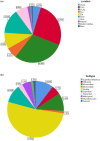Assessing the Concordance of Clinical and Pathological Diagnoses in Basal Cell Carcinoma Among the Iranian Population: A Cross-Sectional Analysis of 229 Cases
- PMID: 39463133
- PMCID: PMC11513546
- DOI: 10.1002/cnr2.70040
Assessing the Concordance of Clinical and Pathological Diagnoses in Basal Cell Carcinoma Among the Iranian Population: A Cross-Sectional Analysis of 229 Cases
Abstract
Background: Nonmelanoma skin cancer (NMSC) is the most prevalent malignancy globally, with basal cell carcinoma (BCC) being the most common type.
Aims: This study aims to evaluate the concordance between clinical and pathological diagnoses of BCC, emphasizing the importance of early detection.
Methods and results: In this cross-sectional study, we conducted a retrospective review of clinical and pathological records for 229 patients diagnosed with BCC between 2020 and 2024. The analysis focused on gender, age, lesion location, and diagnostic accuracy. Among the 229 patients, 193 were men (84.3%), and 131 (57.2%) had recorded clinical diagnoses. The mean age of diagnosed patients was 67.72 years. Lesions were primarily located on the scalp (29.5%), face (26.4%), and nose (13.9%). Of the pathological evaluations, 184 cases (80.3%) confirmed BCC, while 45 cases had alternative diagnoses. Notably, 94.6% of clinically diagnosed patients were suspected to have BCC by their physicians. A significant portion of cases (42%) lacked prior clinical diagnoses, reflecting a potential gap in education among nondermatologists regarding BCC recognition.
Conclusion: The study found high concordance between clinical and pathological diagnoses of BCC, underscoring the need for improved clinical assessment skills among healthcare providers. Collaboration with dermatologists is essential for accurate diagnosis and improved patient outcomes. Enhanced training in recognizing BCC symptoms is recommended to address the identified gaps in clinical suspicion.
Keywords: clinical assessment; diagnostic accuracy; histopathological findings; referral patterns; skin cancer education.
© 2024 The Author(s). Cancer Reports published by Wiley Periodicals LLC.
Conflict of interest statement
The authors declare no conflicts of interest.
Figures
Similar articles
-
Clinicopathological Pattern of Nonmelanoma Skin Cancer in Kuwait: A Retrospective Study.Med Princ Pract. 2024;33(2):133-138. doi: 10.1159/000536010. Epub 2023 Dec 29. Med Princ Pract. 2024. PMID: 38160671 Free PMC article.
-
Patient-reported health outcomes in patients with non-melanoma skin cancer and actinic keratosis: results from a large-scale observational study analysing effects of diagnoses and disease progression.J Eur Acad Dermatol Venereol. 2018 Jul;32(7):1138-1146. doi: 10.1111/jdv.14703. Epub 2018 Jan 12. J Eur Acad Dermatol Venereol. 2018. PMID: 29150868 Free PMC article.
-
Accuracy and predictors of basal cell carcinoma diagnosis.Dermatol Surg. 2005 May;31(5):534-7. doi: 10.1111/j.1524-4725.2005.31156. Dermatol Surg. 2005. PMID: 15962736
-
Dermoscopic criteria and basal cell carcinoma.G Ital Dermatol Venereol. 2016 Dec;151(6):642-648. Epub 2016 Jun 29. G Ital Dermatol Venereol. 2016. PMID: 27356243 Review.
-
Cutaneous amyloidosis mimicking basal cell carcinoma: a case series and literature review.J Plast Reconstr Aesthet Surg. 2024 Aug;95:340-348. doi: 10.1016/j.bjps.2024.06.010. Epub 2024 Jun 12. J Plast Reconstr Aesthet Surg. 2024. PMID: 38959620 Review.
Cited by
-
Successful and Sustained Treatment of Cutaneous Tumoral Lesions in Brooke-Spiegler Syndrome (BSS) Using Ablative CO2 Laser: A Case Series and Literature Review.Clin Case Rep. 2025 May 8;13(5):e70501. doi: 10.1002/ccr3.70501. eCollection 2025 May. Clin Case Rep. 2025. PMID: 40342561 Free PMC article.
References
-
- Emadian M., Afkahaminia F., Rezaei F., Kashiri A., and Shiva A., “Prevalence of Basal Cell Carcinoma in Mazandaran Provinence, 2017‐2018,” Journal of Mazandaran University of Medical Sciences 29, no. 181 (2020): 144–149.
MeSH terms
LinkOut - more resources
Full Text Sources
Medical
Miscellaneous



